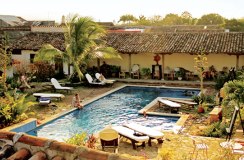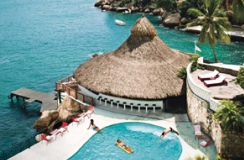For a few hours on the night of Dec. 20 to Dec. 21, the attention of tens of millions of people will be drawn skyward, where the mottled, coppery globe of our moon will hang completely immersed in the long, tapering cone of shadow cast out into space by our Earth. If the weather is clear, favorably placed skywatchers will have a view of one of nature's most beautiful spectacles: a total eclipse of the moon.
Unlike a total eclipse of the sun, which is only visible to those in the path of totality, eclipses of the moon can usually be observed from one's own backyard. The passage of the moon through the Earth's shadow is equally visible from all places within the hemisphere where the moon is above the horizon.
The total phase of the upcoming event will be visible across all of North and South America, as well as the northern and western part of Europe, and a small part of northeast Asia, including Korea and much of Japan. Totality will also be visible in its entirety from the North Island of New Zealand and Hawaii — a potential viewing audience of about 1.5 billion people. This will be the first opportunity from any place on earth to see the moon undergo a total eclipse in 34 months. [Amazing photos of a total lunar eclipse]
This star chart shows where in the sky the upcoming lunar eclipse will appear. And check this NASA lunar eclipse chart to see how visible the eclipse will be from different regions around the world.
Stages of the eclipse
There is nothing complicated about viewing this celestial spectacle. Unlike an eclipse of the sun, which necessitates special viewing precautions in order to avoid eye damage, an eclipse of the moon is perfectly safe to watch. All you'll need to watch are your eyes, but binoculars or a telescope will give a much nicer view.
The eclipse will actually begin when the moon enters the faint outer portion, or penumbra, of the Earth's shadow a little over an hour before it begins moving into the umbra. The penumbra, however, is all but invisible to the eye until the moon becomes deeply immersed in it. Sharp-eyed viewers may get their first glimpse of the penumbra as a faint smudge on the left part of the moon's disk at or around 6:15 UT (on Dec. 21) which corresponds to 1:15 a.m. Eastern Time or 10:15 p.m. Pacific Time (on Dec. 20).
The most noticeable part of this eclipse will come when the moon begins to enter the Earth's dark inner shadow (called the umbra). A small scallop of darkness will begin to appear on the moon's left edge at 6:33 UT (on Dec. 21) corresponding to 1:33 a.m. EST or 10:33 p.m. PST (on Dec. 20).
The moon is expected to take 3 hours and 28 minutes to pass completely through the umbra.
The total phase of the eclipse will last 72 minutes beginning at 7:41 UT (on Dec. 21), corresponding to 2:41 a.m. EST or 11:41 p.m. PST (on Dec. 20).
At the moment of mid-totality (8:17 UT/3:17 a.m. EST/12:17 a.m. PST), the moon will stand directly overhead from a point in the North Pacific Ocean about 800 miles (1,300 km) west of La Paz, Mexico.
The moon will pass entirely out of the Earth's umbra at 10:01 UT/5:01 a.m. EST/2:01 a.m. PST and the last evidence of the penumbra should vanish about 15 or 20 minutes later.
Color and brightness in question
During totality, although the moon will be entirely immersed in the Earth's shadow, it likely will not disappear from sight. Rather, it should appear to turn a coppery red color, a change caused by the Earth's atmosphere bending or refracting sunlight into the shadow.
Since the Earth's shadow is cone-shaped and extends out into space for about 844,000 miles (1,358,000 km), sunlight will be strained through a sort of "double sunset," all around the rim of the Earth, into its shadow and then onto the moon.
However, because of the recent eruptions of the Eyjafjallajökull volcano last spring and the Merapi volcano in Indonesia in October, one and possibly even two clouds of ash and dust might be floating high above the Earth. As a result, the moon may appear darker than usual during this eclipse; during totality, parts of the moon might even become black and invisible.
A careful description of the colors seen on the totally eclipsed moon and their changes is valuable. The hues depend on the optical equipment used, usually appearing more vivid with the naked eye than in telescopes. The French astronomer Andre-Louis Danjon introduced the following five-point scale of lunar luminosity ("L") to classify eclipses:
L = 0: Very dark eclipse, moon almost invisible, especially in mid-totality.
L = 1: Dark eclipse, gray or brownish coloration, details distinguishable only with difficulty.
L = 2: Deep red or rust-colored eclipse, with a very dark central part in the shadow, and outer edge of the umbra relatively bright.
L = 3: Brick red eclipse, usually with a bright or yellow rim to the shadow.
L = 4: Very bright copper-red or orange eclipse, with a bluish very bright shadow rim.
Examine the moon at mid-totality and also near the beginning and end of totality to get an impression of both the inner and outer umbra. In noting an L observation, state the time and optical means (naked eye, binoculars or telescope) that is used. We invite readers to e-mail their Danjon estimate for this eclipse (along with any pictures they'd like to share) to cmoskowitz-at-SPACE.com.
At mid-totality, from rural locations far from city lights, the darkness of the sky is impressive. Faint stars and the Milky Way will appear, and the surrounding landscape will take on a somber hue. As totality ends, the eastern edge of the moon begins to emerge from the umbra, and the sequence of events repeats in reverse order until the spectacle is over.
Fringe effects
Interestingly, from most of New Zealand, a slice of northeast Australia, Papua, New Guinea, southwest Japan and Korea, the moon will rise during totality on the evening of Dec. 21. Because of low altitude and bright evening twilight, observers in these locations may not see much of the moon at all until it begins to emerge from out of the Earth's shadow.
Conversely, much of the United Kingdom and parts of western and northern Europe will see the moon set during totality on the morning of Dec. 21. Because of low altitude and bright morning twilight, observers in these locations may not see much of the moon at all after it slips completely into the Earth's shadow.
Past and future
The last total lunar eclipse occurred on Feb. 20 to Feb. 21, 2008 and was visible from most of the Americas, as well as Europe, much of Africa and western Asia. In 2011, there will be two total lunar eclipses. The first, on June 15, will be visible primarily from the Eastern Hemisphere and will have an unusually long duration of totality lasting one hour and 40 minutes.
Another total lunar eclipse will occur on Dec. 10 and will be visible over the western half of North America before moonset. For the next total lunar eclipse that will be visible across all of North America, we must wait until April 14 to April 15, 2014.
credit : yahoo.com
Tampilkan postingan dengan label Mexico. Tampilkan semua postingan
Tampilkan postingan dengan label Mexico. Tampilkan semua postingan
Minggu, 19 Desember 2010
AmaZinG SpecTacLe: TotaL LunAr EcLipSe MonDaY NighT
Label:
AfRicA,
America,
Asia,
Australia,
England,
Europe,
GunuNg MeraPi,
HaWaii,
InDoNeSiAn,
JapANeSe,
KnowLEdGe,
KoReaN,
Mexico,
NeW GuiNeA,
NeW ZeaLaNd,
Papua
WorLd's BesT NeW BoutiQuE HoTeLs
Hotel Boca Chica
Photo: Dave Lauridsen
More from BudgetTravel.com
Acapulco, Mexico
Hotel Boca ChicaLong before Cancún or Cabo, Acapulco was the king of Mexican resort towns—and the Hotel Boca Chica was its crown jewel, drawing everyone from Elvis to the Rat Pack. Now, after a three-year remodel, the Boca Chica has regained its former sparkle. The 36 rooms are lacquered white and flooded with light, and all have private balconies. Meanwhile, old Hollywood touches throughout—like lamps made from conch shells and latticed brickwork—serve as ever-present reminders of its storied past.
hotelbocachica.com, from $95.

Topia Inn
Photo: Collin Avery/courtesy Topia Inn
Adams, Massachusetts
Topia InnWhen owners Nana Simopoulos and Caryn Heilman set out to restore a 19th-century brick boardinghouse in the Berkshires, they didn't just strive for eco-conscious design—it was more like eco-perfection. Nearly everything in the eight-room Topia Inn is organic, from the breakfast of banana bread, spinach quiche, and fair-trade coffee to the plush mattresses made of chemical-free cotton. Even the walls are plastered with bright, earth-friendly clay, which makes them cooler in the summer, warmer in the winter, and inviting all year long.
topiainn.com, from $125.

Oxygen Jungle Villas
Photo: Courtesy Oxygen Jungle Villas
Uvita, Costa Rica
Oxygen Jungle VillasThe 12 cabins at Oxygen Jungle Villas were constructed with a singular goal: to make you feel like you're the only person for miles. Blissfully isolated among barriers of tropical plants and vines, the one-bedroom villas come off like Swiss Family Robinson tree houses. Each has a private sun-deck, a sharply angled roof, and glass walls to maximize views of the Pacific Ocean a mile away. And considering the adults-only hotel never takes more than 24 guests at a time, it's hardly a stretch to believe the jungle is yours and yours alone.
oxygenjunglevillas.com, from $139.

The Pantone Hotel
Photo: Serge Anton/courtesy Pantone Hotel
Brussels, Belgium
The Pantone HotelWhat's so weird about this pint-size property in Sweden? At first glance, the one-room hotel appears to be a cheery red house in the middle of the lake—yes, it's in the middle of a body of water but how strange is that, really? Don't be fooled: The room isn't actually in the house; it's 10 feet underwater. It's also the only functioning underwater hotel that started out as an art installation. Designed by artist Mikael Genberg, the 10-year-old inn's sole room consists of two twin beds with panoramic windows on all sides. There is no electricity, but there is lighting and a portable gas heater. When ready to come up for air, guests can relax on the deck or take the dinghy out to one of the nearby uninhabited islands.

The Mosaic House
Photo: Cat Norman/courtesy Mosaic House
Prague, Czech Republic
The Mosaic HousePart stylish hotel, part traditional hostel, the Mosaic House is an experience all its own. Inside the six-story 1935 building, guests can opt for one of 64 private rooms (from $26) or one of 30 shared spaces—for nearly half the cost (from $15). While the atmosphere skews toward the casual (think board games and beanbag chairs in the lounge), the decor is more upscale: Each room is done up in chocolate brown, burgundy, and gold, and is accented with quirky touches like closet rods made of tree branches and tables fashioned from salvaged-wood beams.
mosaichouse.com, from $15.

The Nearwater
Photo: Courtesy mrandmrssmith.com
Cornwall, U.K.
The NearwaterCornwall's rugged cliffs, manicured gardens, and 300-plus public beaches have drawn British vacationers since the 1800s. Now the seaside retreat, four and a half hours west of London, has one more draw to add to the list: the Nearwater. At this whitewashed B&B in the town of St. Mawes, owners Tim and Amelia Whitaker have transformed a simple home into one of the area's sweetest small hotels. Bamboo floors, Danish teak furniture, and a mirror made from driftwood give Nearwater a light, nautical look, while the three rooms' beds are covered in sailor-striped wool blankets. Added to that, Amelia's homemade granola and pancakes are the perfect start to a day spent taking one of Tim's famous guided walks along the coast.
nearwaterstmawes.co.uk, from $131 with breakfast.

Ma Maison
Photo: Courtesy Ma Maison
Ho Chi Minh City, Vietnam
Ma MaisonThe last thing you'd expect to find in Vietnam's hyper-kinetic capital is a tranquil French retreat, but such is the pleasant surprise of Ma Maison. Run by Natasha Long, a Saigon local, the inn is housed in a 70-year-old colonial villa remodeled to evoke French country life. Walls are painted in soft yellows and greens, while the 12 rooms have blond-wood beds and desks with gold-leaf details. The hotel's bistro completes the vibe, with a menu full of French fare such as braised chicken with mushrooms. Add to that thoughtful touches like the complimentary mobile phones with free local service and an affable cat, Mr. Sushi, and you'll be feeling like family in no time.
mamaison.vn, from $70 with breakfast. 20. Siem Reap, Cambodia

Sojourn Boutique Villas
Photo: Courtesy Sojourn Boutique Villas
Siem Reap, Cambodia
Sojourn Boutique VillasTThe Sojourn Boutique Villas is the rare resort that soothes your body and soul all at once. The 10 red-and-white bungalows are just a few miles from the iconic temples of Angkor, so guests can spend their days wandering among 12th-century Buddhist ruins and their evenings soaking in the palm-tree-fringed saltwater pool. All that relaxing comes with the peace of mind that Sojourn donates a portion of its proceeds to clean-water initiatives and English lessons for residents of the nearby Treak Village.
sojournsiemreap.com, from $100 with breakfast.

Hotel Spa Granada
Photo: Courtesy Hotel Spa Granada
Granada, Nicaragua
Hotel Spa GranadaIt's one thing to stay in the heart of a Spanish colonial city—and quite another to stay in a Spanish-colonial mansion. Located smack in the middle of Granada's historic district, the sprawling 19th-century Hotel Spa Granada has five garden courtyards, a lagoon-like swimming pool in the center, and 15 expansive guest rooms (some with ceilings as high as 18 feet) that are decorated with handicrafts from a local artisan. A free spa treatment is included with every night of your stay, but the rates are so shockingly affordable—a 60-minute massage is $20, an aloe facial is $10—that a full day of pampering hardly qualifies as a splurge.
hotelspagranada.com, from $49 with breakfast.
credit : yahoo.com
Geraldine Campbell, Kendell Cronstrom, Elaine Glusac, Naomi Lindt, and Mario López-Cordero
Label:
BeLgiUm,
CosTa RicA,
CzEcH RepubLic,
England,
KaMboJa,
KnowLEdGe,
MassAchUseTTs,
Mexico,
NicaRaGua,
PariWisaTa,
VieTnaM
Kamis, 19 Agustus 2010
GadiS-gaDiS CaNtiK DiJaDikaN PemBuNuh BaYaraN
Sebuah gang narkoba Meksiko di Ciudad Juarez menyewa gadis-gadis cantik sebagai pembunuh bayaran. Ini dilakukan untuk mengejutkan rival mereka.
Sekitar 30 gadis berusia 18 hingga 30 tahun dilatih menembak ditemani para pembunuh bayaran. Demikian disampaikan Rogelio Amaya, tersangka anggota gang La Linea yang diterkenal kejam, Rabu (18/8).
Para gadis dipekerjakan untuk mengalihkan perhatian para lawan. Mereka beroperasi sama seperti para pria, menggunakan senjata ringan maupun berat.
Sekurangnya 28 ribu orang tewas akibat kekerasan yang berhubungan dengan narkoba sejak akhir 2006, ketika presiden Felipe Calderon melancarkan operasi militer kontroversial untuk membasmi mafia obat bius di Meksiko.
credit : yahoo.com
republika.co.id
Sekitar 30 gadis berusia 18 hingga 30 tahun dilatih menembak ditemani para pembunuh bayaran. Demikian disampaikan Rogelio Amaya, tersangka anggota gang La Linea yang diterkenal kejam, Rabu (18/8).
Para gadis dipekerjakan untuk mengalihkan perhatian para lawan. Mereka beroperasi sama seperti para pria, menggunakan senjata ringan maupun berat.
Sekurangnya 28 ribu orang tewas akibat kekerasan yang berhubungan dengan narkoba sejak akhir 2006, ketika presiden Felipe Calderon melancarkan operasi militer kontroversial untuk membasmi mafia obat bius di Meksiko.
credit : yahoo.com
republika.co.id
Langganan:
Postingan (Atom)












